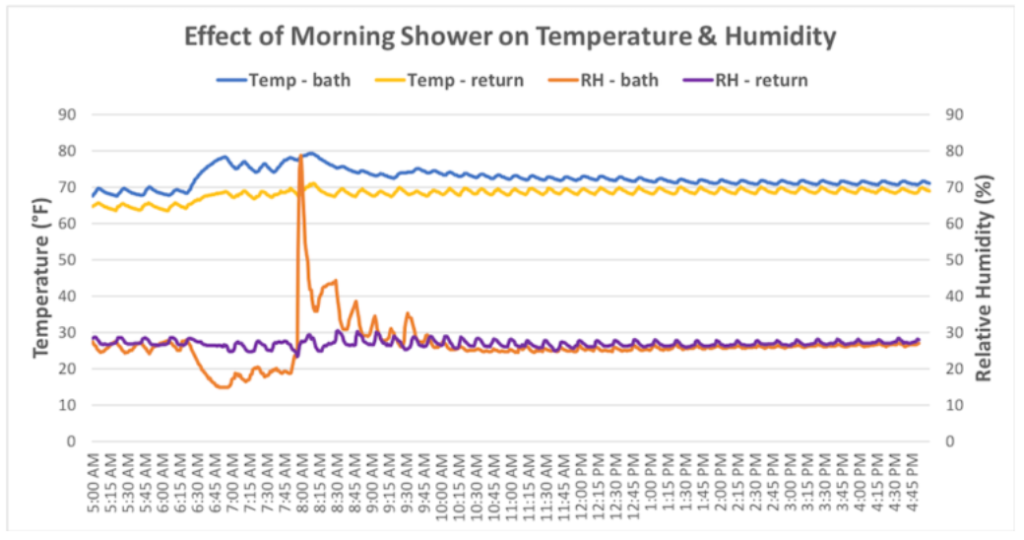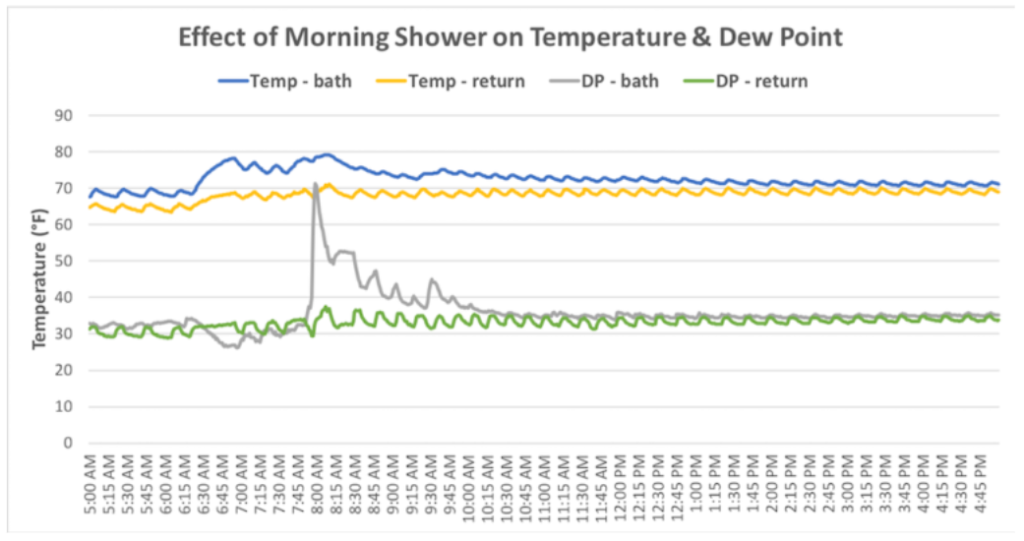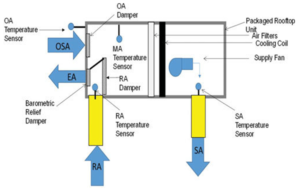2018-01-22 Allison Bailes
You may have heard or read somewhere that you should run your bathroom exhaust fan whenever you take a shower and then let it run for a while after you’re done with the shower. Showers increase the humidity in the bathroom. Sometimes it gets high enough to cause condensation to appear on the mirror and other surfaces in the bathroom. And that can result in mold growth. So you should always run your bath fan when you shower. Or so they say.

Reasons to run the bathroom exhaust fan
Bath fans are a really nice thing to have. I know. I lived without one in my 48 year old condo for years before finally remodeling and installing an exhaust fan two years ago. They do indeed remove moisture. I took that photo above one day last summer after intentionally leaving the fan off so I could get a good picture of condensation. (Yeah, I’m like that.)
But they also remove odors. Bathrooms have been known to be smelly on occasion. You know, with all the candles and incense and hairspray and stuff. Right? Oh, and then there’s the cleaning products. And, in some bathrooms (not mine!), a pile of dirty laundry. Seems like there’s something else, too, but anyway, you get the point. Bath fans are good for removing odors.
Another reason to run the bath fan is if it’s part of your whole-house ventilation system. You can get controls to run them continuously or a certain number of minutes per hour. Some fans have the controls built in. Either way, if the bath fan is part of your whole-house ventilation, you don’t want to turn it off in winter. (By the way, bath fans don’t have to be part of exhaust-only whole-house ventilation. You can pair them with supply fans to have balanced ventilation.)
You may not need to run the bath fan for your morning shower in winter
Now, let’s explore the humidity side of things. Taking a shower increases the amount of water vapor in the air. But that may not be a bad thing. What’s bad about dumping a lot of moisture into bathroom air is when it gets into the porous materials, like drywall, and keeps them wet. When they stay wet long enough, they can start growing mold. Not good.
Let’s look at another aspect of what wintertime does in many homes. What’s the relative humidity in your home when it’s cold outdoors? Remember: Cold air is dry air. It’s not the furnace drying out the air in your home. It’s cold, dry air leaking in, or being pulled in by the mechanical systems and stack effect.
So if your home’s air is really dry, not running the bath fan when you shower may be a good thing. Are you running a humidifier to combat dry indoor air? All the more reason not to run the bath fan.
Think about this: You take a shower, which increases the humidity in the bathroom. So you turn on the bath fan, using energy to suck out the humid air. Then you use more energy to heat the air that has to be made up by the air exhausted from the bathroom. Then you use more energy to run a humidifier because your indoor air is too dry. Hmmmm. Something doesn’t add up here.
Moisture migration after a shower
I live in a 48 year old condo. I’ve done some work to make it more airtight but not enough yet. (OK, if you really want to know why, it’s because our condo association pays the gas bill and I’m behind on retirement savings. Skin lotion is cheaper than replacing the atmospheric combustion appliances. And I have a low-level carbon monoxide detector. There. Now you know.)
When it gets cold, which Floridians think happens way too often and Vermonters believe almost never happens, our indoor air gets pretty dry. We’ve had some cold snaps this winter, and here’s a couple of graphs of data from one of them. The outdoor temperature on this particular day started off at about 25° F and got up to 47° F. (We got 2″ of snow later that night.)
The first graph shows the temperature and relative humidity in the bathroom, up high near the ceiling, and the temperature and relative humidity at the central return vent in the living room. Several interesting points jump out when you look at the graph but let’s focus on the humidity part. It’s not hard to see when I took a 5 minute shower. The relative humidity spiked in the bathroom, going up t almost 80%. And then it started coming down as soon as I turned off the water. The relative humidity drops back to about where it started in about two hours.

The second graph shows the same thing except with dew point instead of relative humidity. Here you can see the real longer term effect of the shower. Although the relative humidity dropped to about the same level it had been before my shower, the dew point stayed elevated. If you understand my previous rants about relative humidity versus dew point, you know the reason. The relative humidity dropped to the same level, but the temperature also was higher. The rising dew point shows that we actually had more water vapor in the air.

When is it OK to leave the bath fan off?
If you think it might help in your home to capture that moisture, here are a few pointers to help guide you.
- If the air in your home is really dry, you may be able to shower without the bath fan running.
- If you run a humidifier, why are you removing humidity from the bathroom?
- If you are attentive to what’s happening in your home, this may be worth a try.
Beware that adding moisture to a home in winter can cause problems. Remember that article I wrote about two rules for preventing humidity damage? If you’ve got humid air, you need to keep it away from cold surfaces. If you’ve got cold surfaces, you need to keep humid air away from them.
There are two keys for making this work for you instead of against you:
- Watch for excessive condensation. When I took the shower for the above graphs, the condensation disappeared pretty quickly because the overall humidity in the home was low.
- This works best if you leave the bathroom door open during the shower. Not everyone can do that so you might need to run the fan at least while you’re in the shower. But if you get out and open the door quickly, you probably can turn the fan off quickly. Watch the condensation. Once it dissipates, you can turn the fan off.
If you decide to experiment with this, be sure to keep an eye out for condensation that lingers and any surfaces in the bathroom that might grow mold. If you can keep those two things under control, you should be fine leaving the bath fan off when you shower in winter. Even if you do run the bath fan for humidity control, the disappearance of condensation is a pretty good guide to when you can turn it off.



